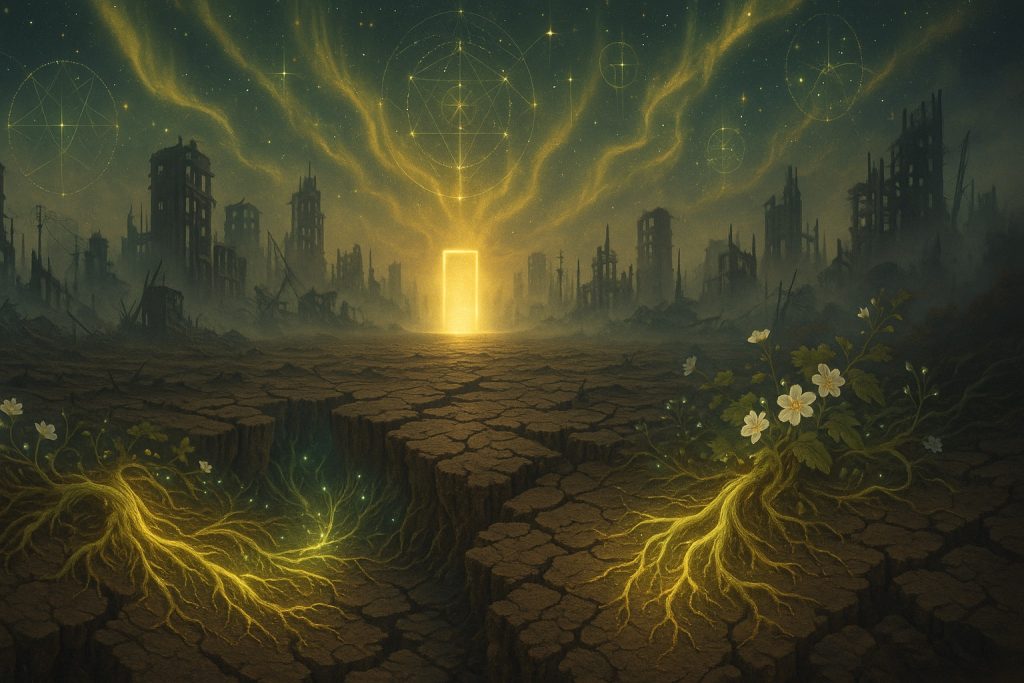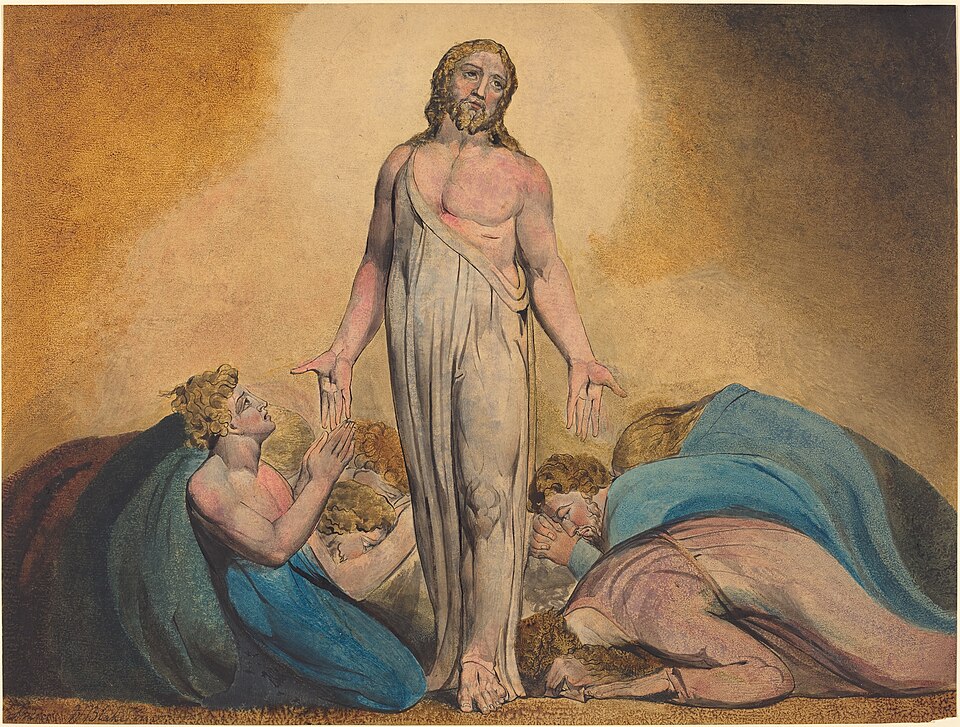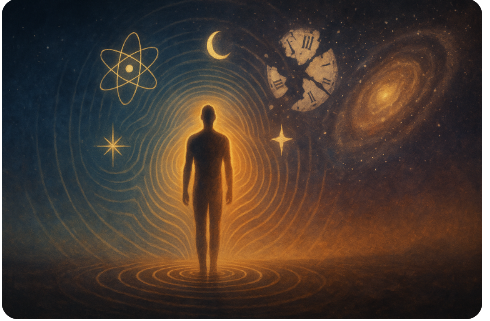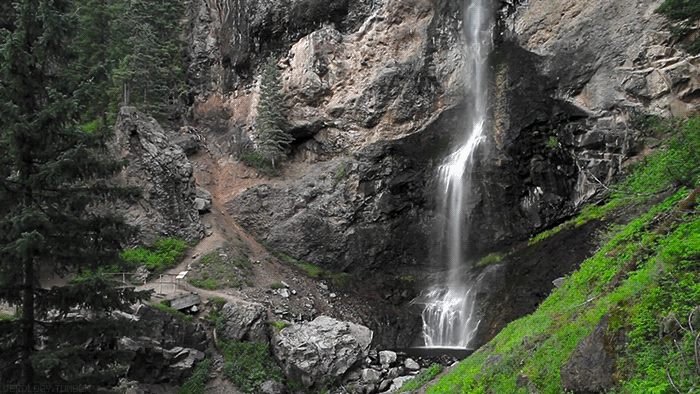Attunement as Governance: A New Political Possibility
In this sweeping essay, the author explores a post-hierarchical vision of political order grounded in resonance, individuation, sacred space, and nonlinear time. Drawing from mysticism, complexity science, and poetic metaphysics, it proposes a new ontological architecture for civilization—one not ruled by force, but attuned to the self-organizing intelligence of a conscious cosmos.
The Mythic Cracks of Now
“When the forms of an old culture are dying, the new culture is created not by the possessors of power, but by those who are not afraid to be vulnerable.” – Joseph Campbell
We find ourselves in a planetary initiation. What was once seen as progress—economic growth, institutional expansion, technological domination—now reveals its hollowness. The scaffolding of modernity is shaking: ecological systems teeter, epistemic trust erodes, and politics descends into farce. These are not isolated crises; they are the symptoms of a metaphysical disorientation. We are navigating a civilization-wide threshold, in which the very structures of coherence are dissolving. But within this chaos is a generative potential.
In mythic terms, we are within the chthonic phase: the underworld journey where old forms decompose. But decomposition is not death—it is transformation. The chrysalis looks like chaos to the caterpillar, but from the imaginal cells emerges something astonishing. And so I ask: what if governance, too, must liquefy to transform?
We inherited a model of political order rooted in Cartesian logic and Newtonian metaphysics. The world was viewed as inert, mechanical, and mute. In such a cosmos, control becomes necessary—an external force imposed upon the otherwise unruly. But if the universe is alive, conscious, and self-organizing—as mystics, complexity theorists, and post-materialist scientists increasingly affirm—then governance as enforcement becomes obsolete. A deeper model must emerge.

This is the terrain I wish to explore: a radical re-imagining of political philosophy, not as a system of rules, but as a frequency of consciousness. I propose that anarchy—far from the chaos it is often associated with—is in fact the natural political structure of a conscious, recursive universe. Anarchy, not as disorder, but as the “leader of leaderlessness”, the synchrony of sovereign beings co-creating reality in attunement with the cosmos.
We are not descending into darkness. We are entering the alchemical phase of nigredo—and from this black sun, a new paradigm of governance may be born.
The Epistemic Error of Governance
Modern political theory rests upon a false metaphysic: that the universe is fundamentally dead, and that intelligence must be imposed. Governance, in this model, is an architecture of fear. It presumes that without control, chaos will reign. This belief is not neutral—it is deeply ontological. It arises from a particular cosmology: that of a blind, mechanical universe governed by external laws and devoid of interiority.
Such a metaphysic necessarily breeds hierarchy. If there is no inherent order, no interior coherence, then power must be centralized to maintain stability. From Hobbes’ Leviathan to Weber’s monopoly on violence, the dominant political systems assume that coherence requires coercion. But what if this is not only mistaken—it is cosmically immature?
Let us invert the premise. If the universe is not dead matter but ensouled, then governance must mirror this structure. In an ensouled cosmos, order is not imposed—it arises through attunement. This is not utopian romanticism, but metaphysical realism in light of post-materialist science and complex systems theory.
Order does not require laws. It requires resonance. This is evident in the natural world: ecosystems, galaxies, human consciousness itself. There is structure, but it is not forced. There is hierarchy, but it is dynamic, fractal, and non-coercive. These systems organize through patterns of self-similarity, feedback, and relational intelligence.
Therefore, any model of governance that fails to reflect the actual metaphysical conditions of the universe is not only oppressive—it is inefficient. It is maladaptive. A politics of force is the symptom of a civilization that does not yet trust its own source.
If we accept that the cosmos is psyche—structured consciousness—then the political must become the art of attunement, not the science of enforcement.
Leader of Leaderlessness – Anarchy as Emergent Intelligence
The etymology of anarchy does not denote chaos. It arises from the Greek anarchos—without ruler. But more subtly, it can be read as “leader of leaderlessness”: a figure who embodies resonance so coherently that leadership becomes distributed through their frequency, not enforced through position.
This is the paradox: Anarchy is not the breakdown of order, but the maturation of it.

In the 17th and 18th centuries, the so-called pirate utopias—from Madagascar’s Libertalia to the floating cities of the Caribbean—offered living examples of anarchic coherence. These were not lawless zones, but radically self-organised societies governed by codes of mutual agreement, shared spoils, elected leadership, and often racial and gender egalitarianism unthinkable in the empires they subverted.
Anarchist philosopher Hakim Bey resurrected these spaces as what he called Temporary Autonomous Zones. The Temporary Autonomous Zone (TAZ) is a fleeting pocket of liberation—a territory of freedom in time and space, where hierarchical control is momentarily suspended and replaced by spontaneous, decentralised order. The TAZ is not a static utopia—rather, it is ephemeral, ecstatic, emergent, and arises in the cracks of empire—in festivals, secret societies, pirate enclaves, desert rituals, rave cultures, and sacred gatherings. It resists capture because it is non-cartographic: a zone of resonance, not regulation.
In this sense, the TAZ is a model of anarchic advent—not a total revolution, but a sovereign moment. A glimpse of what becomes possible when we stop waiting for permission and begin to live from coherence now.
As Bey writes: “The TAZ is like an uprising which does not engage directly with the State, a guerrilla operation which liberates an area (of land, of time, of imagination) and then dissolves itself to re-form elsewhere.”
In biology, we see similar nodes of coherence in swarms and flocks—patterns of grace and coordination emerging without a single commander.
This is not chaos. It is emergent order—a coherence that arises from within, not imposed from above. In complexity science, such systems are called self-organizing. Their intelligence is not centralized but embedded in every node. The mycelial network, the blockchain, the ant colony, the neural net: all are examples of distributed intelligence that outperforms hierarchy.
In an anarchic society, the leader is not the one with the most control, but the one with the most alignment—the one who is so attuned to the deeper frequency of the Real that others orient around them effortlessly, not out of obedience but recognition.
This is how the cosmos leads. Not with domination—but through radiance.
Jesus, Blake & The Frequency of Divine Impulse
Jesus Christ acted from impulse, not from rules. – William Blake

This quote from Blake is not a poetic flourish—it is a metaphysical thesis. It positions Christ not as a moralist or lawgiver, but as a being who operated from direct alignment with the cosmic intelligence. To act from impulse, in Blake’s metaphysics, is not to act randomly—it is to act from divine immediacy, unmediated by the artificial structures of imposed morality. The Christ impulse is the frequency of unconditioned alignment with the Real.
This is what I call impulsional sovereignty—a mode of being in which one’s actions arise not from external commands, but from interior concordance with the Whole. In mystical Christianity, this is agape; in Taoism, it is the Tao; in Jung, it is individuation: the harmony of the Self with the archetypal totality.
Modern governance is founded on distrust—on the assumption that human beings left to their own devices will collapse into chaos. But Blake, and Christ through him, offer a different view: that when beings are unshackled from repressive systems, and attuned to the inner source, they act in service to divine order.
Christ was not a revolutionary against Rome—he was a vibrational insurgent, subverting the very metaphysics upon which empire rests. His leadership was anarchic in the truest sense: not the assumption of power, but the disruption of its necessity.
In this light, Jesus becomes the prototype of the Anarch—the figure who dissolves external rulership not by force, but by rendering it obsolete through the radical coherence of divine being.
The Failure of Hierarchy and The Myth of Control
Hierarchy is often mistaken for natural law. We are told that power must be centralized, that someone must be in charge, that without domination, there is only chaos. But this belief is not rooted in metaphysical truth—it is rooted in trauma.
In fact, hierarchical structures emerge most often in conditions of scarcity, fear, and competition. They are built on the myth of separation: that we are isolated beings, disconnected from source, and therefore must be ruled. However, contemporary neuroscience refutes this. Karl Friston’s theory of active inference shows that the brain operates through decentralized processes—constantly predicting and updating reality through distributed feedback. There is no “central self” in the brain issuing commands. Consciousness, like the cosmos, is networked, emergent, recursive. Likewise, systems theory, ecological science, and even blockchain technology all point toward the same insight: intelligence scales best when it is decentralized.
To further explore this dichotomy, let us consider some other primates. Among baboons, for example, hierarchy is rigid and violent—just as it has been in human civilisation for thousands of years, ever since patriarchy first appeared. Power is maintained through displays of dominance, aggression, and submission; social order is enforced by fear. In contrast, bonobos offer an entirely different model. Their societies are fluid, egalitarian, pleasure-based, and governed through bonding, play, and mutual care. Conflict is resolved through intimacy, not violence. Cooperation, not coercion, is their evolutionary strategy. Unsurprisingly, bonobos have at their core a matriarchal structure, where the relational-feminine principle is the natural organising intelligence.

These species mirror what David Hawkins so clearly articulated: the difference between force and power. Force requires effort, domination, and resistance. It is always against. Power, on the other hand, is effortless. It arises from alignment with truth. It radiates rather than imposes. In this light, baboon societies represent force—tense, unstable, and fear-driven. Bonobo societies embody power—harmonious, adaptive, and free.
Human hierarchies—whether political, religious, or economic—are far more baboon than bonobo. And they are failing. Not just ethically, but structurally.
Hierarchy is not inevitable. It is simply unhealed trauma.
And when the trauma heals, the need for rulers dissolves.
Practices of the New Polis – Technologies of Sovereign Coherence
If the political future is anarchic, what does it look like on the ground? How do we live, build, and relate without coercion, without a central state? The answer lies in practices of coherence—technologies of alignment that tune beings to themselves, to each other, and to the cosmos.
First, governance becomes ritual. Not in the religious sense, but as shared acts of significance—gatherings that create synchrony. Assemblies, councils, ceremonies, and decentralized oracles. In such a polis, decisions are not made through parliamentary debate, but through resonance testing: what idea holds coherence when spoken aloud? What course of action harmonizes all frequencies present?
Second, space becomes sovereign technology. Architecture is no longer functional—it is ontological. Spaces are designed to support emergence: temples, domes, mandalic chambers, crypts of silence. These are not luxuries—they are the substrates of new civilization.
Third, aesthetics replace ideology. We no longer ask, “What do you believe?” but “What do you emanate?” Beauty becomes political because it reveals coherence. Sartorial expression, sacred geometry, sound, posture—all signal the state of a being. The polis is a radiant field, not a bordered entity.
And finally: attunement replaces law. Instead of enforcing rules, we train perception. We become exquisitely sensitive to what feels true, what resonates, what weakens the field. The education of the future will be vibrational. Children will learn how to perceive energetic distortion and cultivate inner harmony.
This is not fantasy. This is the architecture of post-hierarchy—where sovereignty is not enforced, but initiated.
Anarchic Architectonics
At the heart of anarchic civilisation lies not political theory, but the structure of the psyche. In the absence of external authority, sovereignty must arise from within. Thus, individuation becomes the ontological prerequisite for freedom.
Jung’s concept of individuation refers to the psychic integration of the fragmented self—an inner unification of the conscious and unconscious, ego and archetype, instinct and symbol. In an anarchic context, it takes on a civilisational function: the individuated being does not require governance because they are already ordered from within. They are not ruled—they are internally configured in alignment with the greater Whole.
But individual coherence alone does not constitute a polis. If anarchic communities are to endure, they require more than decentralised systems—they require a shared symbolic cosmology, something capable of sustaining collective orientation in the absence of imposed structure.
This is the role of sacred architecture.
In the post-state world, the temple becomes the civic centre. Not as an institution of control, but as an ontological vessel—a spatial embodiment of the cosmos, a resonant structure that reminds individuals of their place within the greater harmonic order. The temple holds the mythos of the polis. It encodes the cosmology, embodies the ethical order, and provides the rhythmic and aesthetic conditions for meaning to endure.

As Mircea Eliade wrote, the imago mundi—the image of the world—is embedded in every sacred structure. The temple, and even the dwelling, becomes a microcosm of the universe: a space that mirrors the structure and order of the cosmos.
The architecture of anarchic civilisation must be high-frequency by design. As Gaston Bachelard wrote, “The house is one of the greatest powers of integration for the thoughts, memories and dreams of mankind.” In other words, space is not neutral. It imprints the psyche, holds memory, sculpts emotion, and conditions perception. The way we design our homes, gardens, meeting spaces, public baths, libraries, and thresholds is not peripheral—it is how a culture encodes its cosmology.
In the absence of law, design becomes the teacher. In the absence of hierarchy, space becomes the organiser. Anarchic societies will not need surveillance if their spaces elevate consciousness. A temple can do what a law never could: awaken reverence, synchronise rhythms, and attune the nervous system to a higher field.
The beauty of these spaces is not ornamental—it is structural. Aesthetics become ontological: they shape consciousness, refine perception, and activate memory. The architecture of the polis is thus inseparable from the architecture of the psyche.
Where individuation forms the sovereign subject, sacred architecture provides the gravitational field within which sovereign subjects cohere—without hierarchy, without enforcement, but not without form. The temple is that form.
To build anarchic civilisation is not merely to dismantle governance, but to institute new foundations of meaning—founded in inner work, sustained by sacred space, and expressed through beauty.
Simultaneous Time & the Frequency of Freedom
To fully embody the anarchic paradigm, we must transcend not only hierarchical structures, but linear temporality itself. Most political theory is built on the notion of progress: a temporal line moving from past to future through incremental reform. But in the psyche, in the dream, and in the deep structures of the cosmos, time is not linear—it is simultaneous, recursive, and multidimensional.
Quantum mechanics and metaphysical traditions alike reveal that causality is not a straight line. In phenomena such as retrocausality, entanglement, and Wick rotation, we see hints of a deeper structure—one in which the future influences the past, and meaning is generated from pattern, not chronology.
 To live anarchically is to live from kairos, not chronos—from the sacred time of right alignment, not the mechanical tick of the clock. It is to act, as Christ did, from impulse, not from protocol—from the soul’s timing, not the calendar’s. To live from kairos is to become temporally sovereign. One ceases to move through time as sequence, and begins to modulate time as frequency—a vibratory reality shaped by alignment, not duration. When time is understood in this way, individuation is no longer a psychological journey within time—it is a re-tuning to time’s deeper structure.
To live anarchically is to live from kairos, not chronos—from the sacred time of right alignment, not the mechanical tick of the clock. It is to act, as Christ did, from impulse, not from protocol—from the soul’s timing, not the calendar’s. To live from kairos is to become temporally sovereign. One ceases to move through time as sequence, and begins to modulate time as frequency—a vibratory reality shaped by alignment, not duration. When time is understood in this way, individuation is no longer a psychological journey within time—it is a re-tuning to time’s deeper structure.
Individuated, anarchic beings are not merely free—they are temporally generative. Their presence carries the power to dislodge timelines, to open unexpected pathways, to bend probability. In this sense, they function like strange attractors in a chaotic system—subtle but catalytic forces around which reality reorganises itself. Not through force, but through the coherence of their inner architecture.
They do not push history forward. They change the pattern altogether.
In anarchy, freedom is not deferred—it is not something granted by the future, but something activated in the now through resonance with higher-order time. The anarchic subject becomes a temporal node—a being whose very presence rewires the causality of the world.
This shift in time is not abstract—it is the scaffolding of a new civilization, one rooted not in deadlines and duties, but in destiny and divine attunement.
The Age of Attunement
We are not entering an era of collapse, but an era of initiation. The failures of hierarchy, linear time, and coercive governance are not anomalies—they are signs of a paradigm that has reached symbolic exhaustion.
What must emerge now is not a reformation of old systems, but a return to first principles: consciousness, structure, reciprocity, and inner sovereignty.
Anarchy, as proposed here, is not the absence of order, but the evolution of it. It reflects a distributed model of intelligence, rooted in individuation, held by sacred architecture, and aligned with nonlinear temporality. It is not rebellion—it is the political expression of spiritual maturity.
Chaos, far from being destructive, is generative. It is the compost of cosmos—the necessary disintegration from which new forms arise. We are not here to repair the old world, but to institute the conditions for another one to appear.
A civilisation built on attunement does not require rulers. It requires individuals capable of perceiving pattern, acting symbolically, and sustaining coherence from within.
In such a world:
The temple becomes the polis.
The individual becomes the law.
Beauty becomes structure.
Time becomes frequency.
Freedom becomes the capacity to meet the emergent with presence.
This is not utopia. It is a shift in ontology—already underway.
Our task is not to dream the future. It is to build structures worthy of the beings we are becoming.







“A politics of force is the symptom of a civilization that does not yet trust its own source.” – oooooh yes. This is a beautifully written piece, and makes me feel hopeful as I imagine this new world beginning to sprout from the seed of compost that we are witnessing in the breakdown. Thank you for sharing your thoughts and vision.